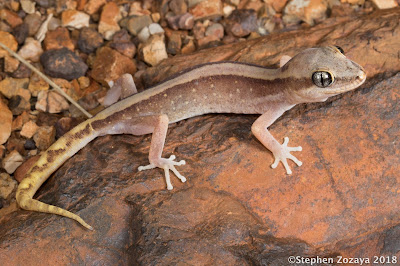 |
| Lucasium iris Vanderduys, Hoskin, Kutt, Wright & Zozaya, 2020 |
Abstract
The Einasleigh Uplands bioregion of central north Queensland, Australia, harbours a unique suite of reptiles that have begun to receive significant attention in the last 20 years. This has resulted in a number of new reptile species being described, and recognition that others await description. We describe a new species of Lucasium Wermuth, 1965 from the western Einasleigh Uplands. Lucasium iris sp. nov. is genetically distinct and morphologically diagnosable from all congeners by its large size, long and narrow tail, nares in contact with rostral scale, homogeneous body scales, distinct vertebral stripe, and paired, enlarged, apical subdigital lamellae. It is known from low rocky hills in a localised area of the Gregory Range, has the most restricted known distribution of any Lucasium, and is the only Lucasium endemic to Queensland. The new species appears most closely related to L. steindachneri (Boulenger, 1885), based on mitochondrial DNA sequences, but has a colour-pattern more similar to L. immaculatum Storr, 1988. All three of these species occur in the Einasleigh Uplands, but only L. steindachneri is known to occur in sympatry with L. iris sp. nov. In addition to the description of the new species, we present records of Lucasium immaculatum from the Einasleigh Uplands, which represent a significant known range extension.
Keywords: Einasleigh Uplands, Lucasium iris sp. nov., Lucasium immaculatum, Lucasium steindachneri, Gregory Range, Reptilia
Lucasium iris sp. nov.
Eric Vanderduys, Conrad J. Hoskin, Alex S. Kutt, Justin M. Wright and Stephen M. Zozaya. 2020. Beauty in the Eye of the Beholder: A New Species of Gecko (Diplodactylidae: Lucasium) from inland north Queensland, Australia. Zootaxa. 4877(2); 291–310. DOI: 10.11646/zootaxa.4877.2.4




